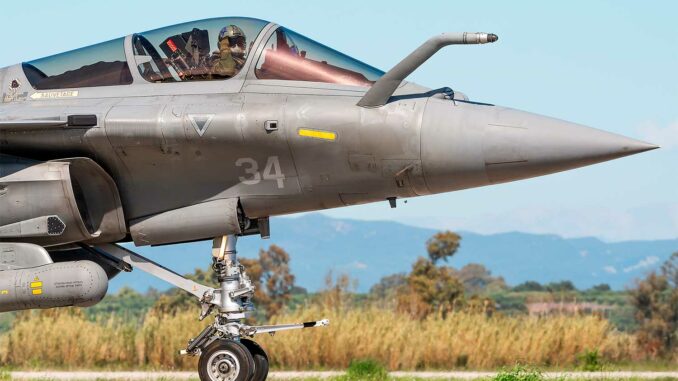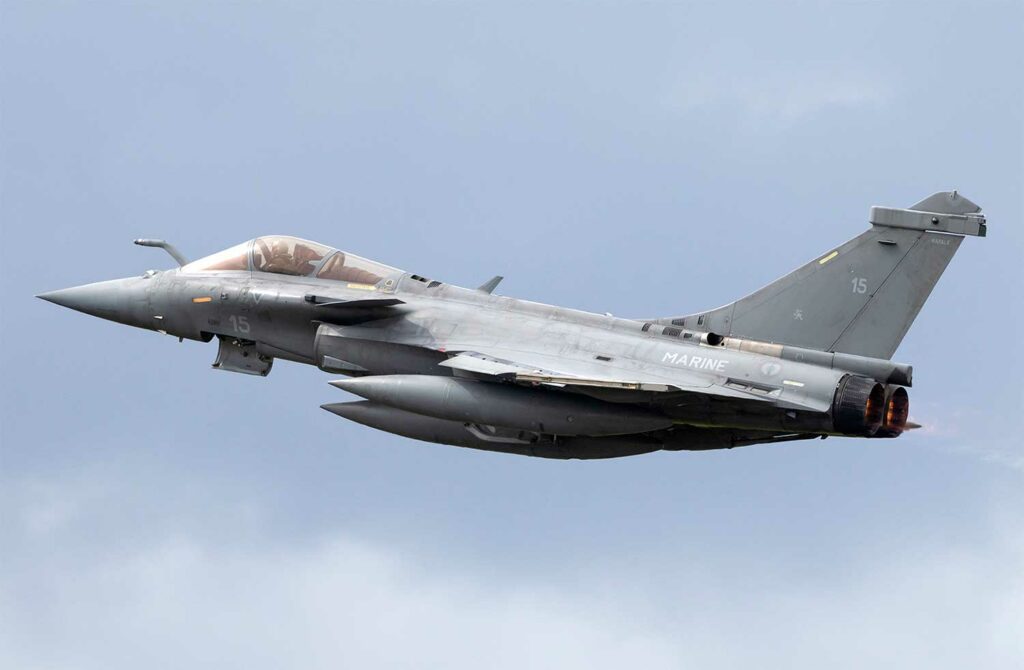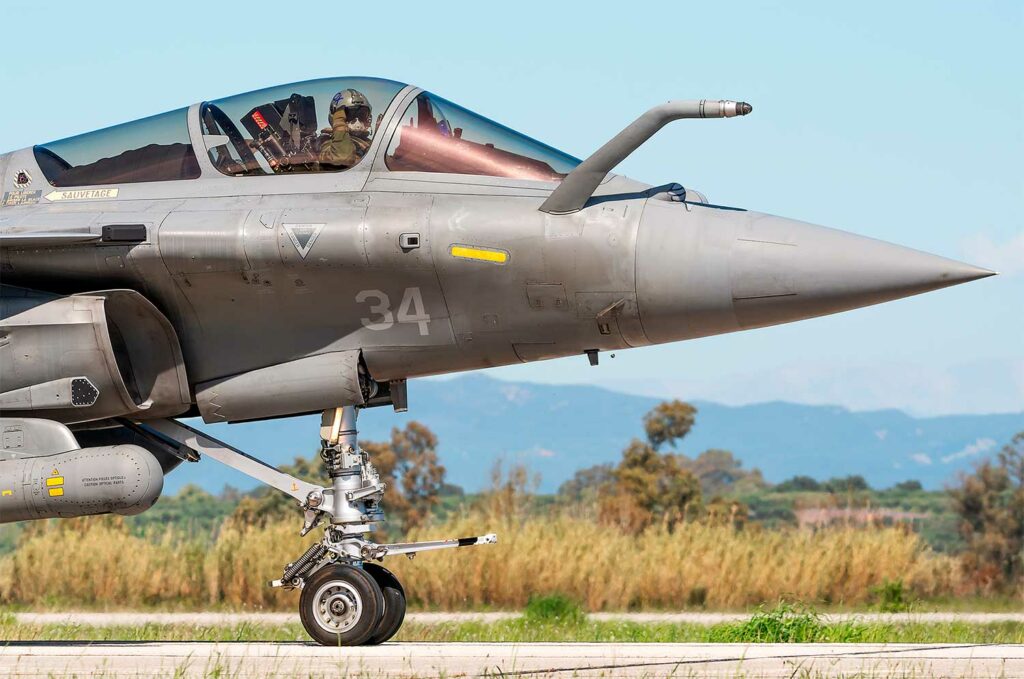
In June 2025, India signed a contract worth ₹630 billion (≈ US$7.4 billion) with France for 26 Rafale-M fighter jets, improving its naval air capability.
On June 23, 2025, India concluded an agreement worth approximately 630 billion rupees (≈ US$7.4 billion, or approximately €6.8 billion) with France. This purchase covers 26 Rafale-M aircraft, the naval version of the famous Rafale fighter jet, intended for the Indian Navy. India thus intends to modernize its airborne capabilities in response to growing maritime challenges in the Indian Ocean. The contract, signed just before June 25, confirms France as a major industrial and strategic partner in Indian defense.
The agreement includes 22 single-seat Rafale-M aircraft and four two-seat conversion aircraft, adapted for air superiority, ground attack, reconnaissance, and anti-ship missions. The package also includes five years of logistics, a training and maintenance package, and technology transfer elements to prepare for the integration of components into Indian industry.
This contract marks a turning point: India becomes the first country outside France to operate the naval variant of the Rafale, strengthening its fleet on the INS Vikrant and INS Vikramaditya. The first deliveries are expected between 2028 and 2030, with an Indian demonstrator within 18 months. The choice simultaneously strengthens France-India defense diplomacy and promotes Indian industry through the Make in India initiative.
Details of the contract and its technical implications
The contract was approved by the Indian Cabinet Committee on Security (CCS) on April 9, 2025, and then officially signed on April 28 via a government-to-government agreement. It includes:
- 22 single-seat Rafale-M and 4 two-seat aircraft for advanced training, exclusively for naval aviation.
- A complete set of weapon systems: MBDA Meteor missiles, Exocet anti-ship missiles, SCALP cruise missiles, plus integration of the Indian Astra missile.
- A five-year performance-based logistics package covering parts, tools, and support.
- Simulators and training centers for recruits and technicians.
- The establishment of local maintenance capabilities, including a Dassault-Tata plant in the Hyderabad region for fuselage manufacturing, managed by Tata Advanced Systems Limited.
Each aircraft, with an empty weight of approximately 10 tons and a wingspan of 10.90 meters, is designed to operate from the INS Vikrant runway. Its naval modifications include a reinforced landing gear, a Doppler radar adapted to the deck, a catapulting beard system, and structures treated against salt corrosion.

Operational advantages for the Indian Navy
The arrival of the Rafale-M will give the navy greater credibility in terms of power projection. Currently, the naval air fleet relies mainly on aging MiG-29Ks.
The Rafale-M offers:
- Increased range thanks to 11,500 kg of internal fuel, coupled with in-flight refueling capability, enabling longer missions in maritime areas.
- A payload of 9 tons, greater than that of the MiG-29K, with internal payloads reducing the radar signature.
- Compatibility with long-range air-to-air weapons and SCALP or Exocet cruise missiles, for a versatile response to air and maritime threats.
- The ability to participate in multinational naval exercises, enhancing interoperability with allies, particularly France (ex-Varuna 2025 has already integrated simulated Rafale-M aircraft).
The planned training includes crew rotations in France, followed by exercises on the INS Vikrant under real conditions. The Rafale-M will be able to operate in tandem with NH-90/Sea King helicopters, patrol around submarines, and intervene on remote coastal installations.
Industrial impact and technological advancement
The contract includes targeted technology transfer, strengthening the Indian aerospace industry. Dassault and Tata Advanced Systems have signed mass production agreements in Hyderabad to manufacture local fuselages. This partnership is in line with the Make in India initiative.
Measurable benefits:
- Estimated creation of several thousand jobs in engineering, production, and maintenance.
- Development of local engineering capabilities to meet Dassault’s quality standards, opening up export opportunities to other user countries.
- Integration of Indian systems such as Astra into the Rafale-M chain, confirming a pragmatic choice in the face of budgetary and political constraints.
This industrial momentum is linked to a gradual transfer to future Indian programs, such as the HAL TEDBF (naval combat) and AMCA, allowing the skills acquired to be used in the long term.
Geostrategic and regional challenges
India is strengthening its position in the Indian Ocean in the face of China’s growing naval power and Russia’s military presence. With its projection capability and precision weapons, the Rafale-M is becoming a mastered tool of credible deterrence in sensitive areas such as the Strait of Hormuz and the Bay of Bengal.
The acquisition is taking place within a strengthened diplomatic framework:
- The Indo-French relationship, developed through the Varuna exercises and the Scorpène and Rafale cooperation programs, is establishing itself as a secure link in the face of American and Chinese pressure.
- Participation in NATO maritime operations and international coalitions is facilitated, despite India’s non-membership of NATO.
- The modernization of the naval air arsenal reduces dependence on Russian equipment, in line with Delhi’s desired policy of strategic diversification.
This contract also affects the regional balance:
- Neighbors such as Pakistan will observe the evolution of India’s naval capabilities.
- China will monitor the rise in power in its supply corridor to Djibouti.
- Indian diplomacy gains leverage in international negotiations related to maritime security.

Outlook
The 630 billion rupee contract for 26 Rafale-M aircraft marks a turning point: with deliveries scheduled between 2028 and 2030, the Indian Navy will receive a fourth-generation naval aircraft, completing its existing arsenal.
This strategic choice is based on solid foundations:
- Enhanced French technological support,
- Local industrialization via Dassault–Tata,
- The ability to maintain the weapons cycle at a controlled cost of ownership.
For India, the Rafale-M is a step towards a stronger navy capable of aligning itself with Western standards. It also creates a ripple effect for future programs such as the TEDBF and helps to assert the country’s position as a regional leader.
Overall, this contract reinforces France’s position as a key defense partner and establishes the Rafale as a European defense technology platform independent of the US.
War Wings Daily is an independant magazine.